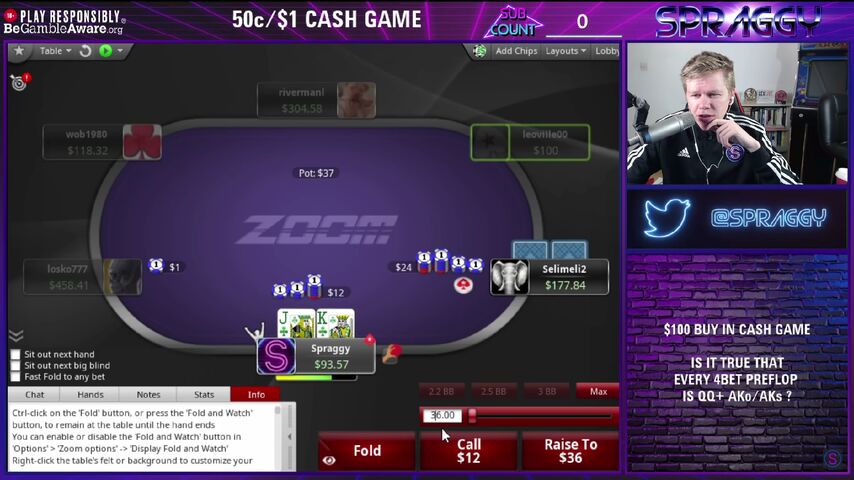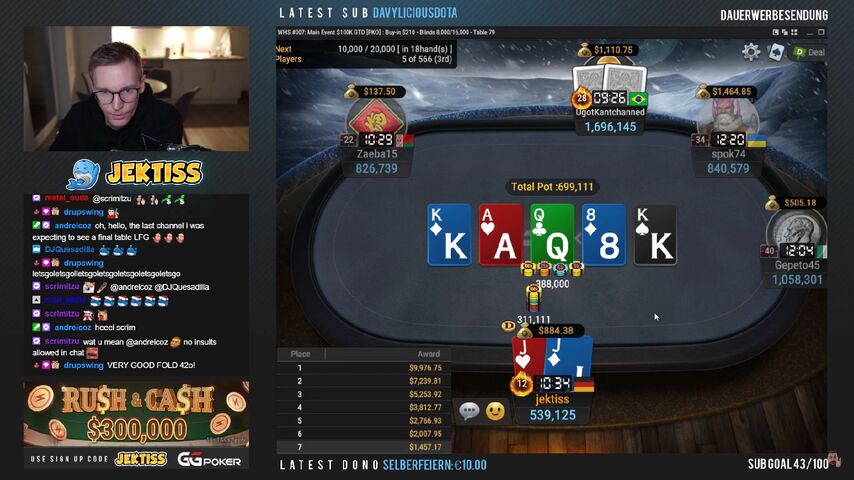Loose poker players are usually willing to put chips into the pot more than other players. They play a wider range of hands, which can cost them a lot of chips. Loose players are known for chasing draws too, even if the odds aren’t optimal.
Some players use a loose style of poker to play aggressively and exploit opponents. Unfortunately, the probability of facing opponents with stronger hands rises by playing more hands, so it’s generally a losing strategy for most players. We divide this style into loose-aggressive and loose-passive.
Some players want to know how to play loose poker, but it’s not easy. Pairing looseness with aggression can work, but you’ve got to be a skilled postflop player. Let’s talk more about why loose poker can be risky, how to spot a loose player, and how to avoid being one.

Here is Why Loose Poker (Usually) Isn’t Profitable
It’s not hard to see how being loose at the poker table can be risky.
When you play more hands, the average strength of your hands decreases. Some loose players counteract this by being skilled at postflop poker and using this advantage to exploit their opponents. When you play a higher-than-average amount of hands, your opponents know that your hand strength is probably weaker when you enter pots.
Loose poker players can have profitable sessions and run “hot”, but they’ll usually lose lots of money preflop and generally be weaker than their opponents.
Loose players also tend to ignore their position at the poker table, which puts them at another disadvantage.
Most players at micro and low-stakes cash games and tournaments will be loose-passive or loose-aggressive. When our team looked at PokerStars online cash games, many of the players had a loose style. In both Texas hold ‘em and Omaha, players were significantly looser at micro and low-stakes tables.

If you want to give PokerStars a try, we’ve done a full review of their cash games, sit & go’s, multi-table tournaments, and other formats like Zoom (fast-folding poker). New players can get a $30 Freeplay Bonus and other rewards.
How to Know If a Poker Player is Loose
It won’t take long to notice the loose player(s) at the table. They’ll be involved in lots of hands and might play more hands than they fold. Any player who plays more than 30% of their hands could be considered a loose player.
Loose poker players are generally loose-aggressive or loose-passive.
- Loose-aggressive players play more hands but exploit weaknesses in their opponents.
- Loose-passive players try to see as many flops as possible and play passively (rarely bluffing, only calling when they have connected with the community cards, folding too often, etc).
Loose players have a higher VPIP than other players at the table. VPIP stands for Voluntarily Put in Pot. You’ll see a percentage that shows how often your opponent willingly puts chips in the pot (small and big blinds do not count toward VPIP).
Average VPIPs for Texas Hold ‘em Poker:
- Around 15% to 21% on 9-player tables
- Around 22% to 30% on 6-player tables
Some poker rooms will show your opponents’ VPIP at the table, but most sites don’t offer a built-in heads-up display. GGPoker is the exception; they’ve got a built-in SmartHUD to show you things like VPIP, PreFlop Raise, your record against a specific player, all-in tendencies, and lots of other information. You can use GGPoker’s SmartHUD to measure how tight or loose your opponents are and adapt.

In general, you’ll find lots of loose players at micro and low-stakes cash games. Texas hold ‘em and Omaha have the most traffic on the site, but their tournament line-up is just as busy. Players are looser at small buy-in tournaments like the Daily Turbo $500 for a $1 buy-in and tighter as the entry fee increases.
Check it all out in our full GGPoker review, including software, games, rake, and bonus information.
How to Avoid Being a Loose Poker Player
Here’s some poker strategy to help you become a tighter player at the table.
Play a conservative amount of hands. Beginners see potential in lots of different hands, but you should have a tight preflop range. Enter the pot with strong hands like pocket pairs, broadway connectors (Ace-King, King-Queen, Queen-Jack, Jack-10) and mix in a small amount of mid-strength hands. Loose players make the mistake of playing too many low and mid-strength hands, which their opponents can exploit.
Think about your position at the table. You want to have the advantage of seeing your opponent’s action first, allowing you to navigate more easily as the betting rounds go on.
Adapt to the table dynamics. Notice the tendencies of other players and think about how many hands they are playing. Who are the loose players at the table? Getting to know your opponents can help you adapt and profit from table dynamics.
- Increased first deposit bonus
- Increased rakeback and reloads
- Help with deposits and cashouts
- Access to private freerolls
- Round-the-clock support
These Are Some of The Loosest Poker Players
Some poker pros are legendary for playing tons of hands with lots of aggression. It’s great to watch, but it keeps you on the edge of your seat. These loose players are usually involved in big pots and big bluffs.
Alan Keating: Hustlers Casino has attracted a lot of high-stakes action. Lots of money on the table doesn't always mean players will be tight. Nobody knows that more than Alan Keating, who sometimes has a VPIP of around 90%. It doesn’t always go Alan Keating’s way, and at one point he was down over $1.6 million on the show.
David “Viffer” Peat: “I have been a millionaire and broke a few times in a week.” We don’t have exact VPIP stats for Viffer, but he’s known for aggression and rarely folding.
Tom ”durrrr” Dwan: This American poker player went from the highest stakes online to appearing on television in the biggest games. His aggression was a huge challenge for the old guard of the poker world, as we saw on Poker After Dark. Tom Dwan was the biggest winner on the High Stakes Poker show, with a VPIP of 54% and $1,756,500 in winnings.






























